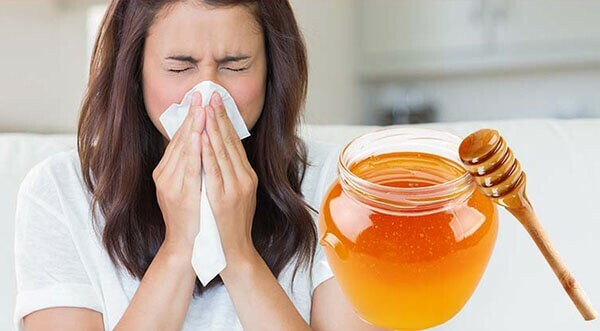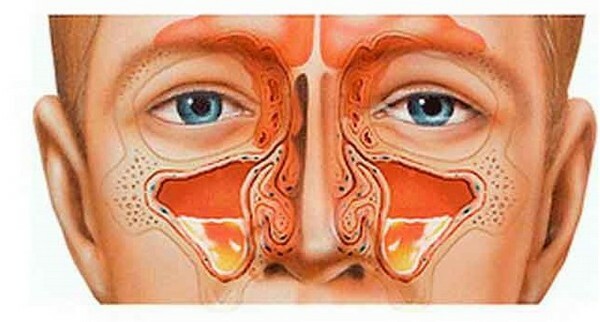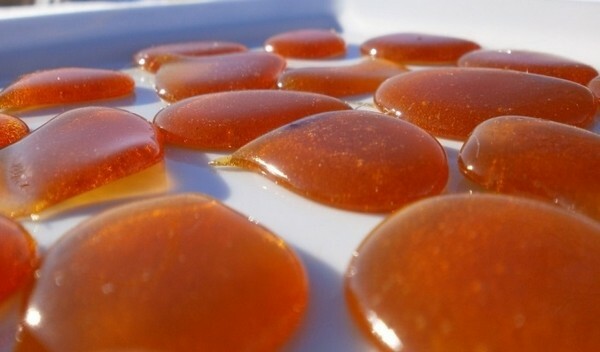- What is the risk of sinusitis?
- What kind of honey is useful?
- How to treat?
- Contraindications
- Recipes
Genyantritis is a rather unpleasant disease affecting the maxillary sinuses of the upper jaw. This pathology can become a complication of influenza, colds, scarlet fever and many other viral and bacterial infections. The sinusitis is usually conservative, but in severe cases surgical intervention may be required. Treatment of maxillary sinusitis with honey is well combined with antibacterial and other drugs aimed at eliminating the source of infection. This product contains a large number of trace elements, nutrients, vitamins and other natural ingredients, so necessary in the fight against this ailment.

What is the risk of sinusitis?
The peak incidence of sinusitis occurs during the autumn-winter period. As a rule, such patients previously had a cold or flu, but due to special circumstances their condition worsened and was complicated by infection of the maxillary sinuses. The most susceptible to this disease are children, as well as adults with weakened immune defenses. Typical symptoms for sinusitis are:
- Nasal congestion;
- Temperature rise;
- Headaches;
- Detachable from the nasal cavity;
- General weakness and fast fatigue.
All of the above symptoms are not highly specific and are observed in many other infectious diseases, so the diagnosis of sinusitis can only be made by a specialist, based on the conclusion of an X-ray. Not so terrible inflammation of the maxillary sinuses as its complication. If the sinusitis has a latent flow, it is often complicated by sepsis. If the genyantritis is purulent or chronic, it is not uncommon for meningitis or even brain abscess to develop in such patients.

What kind of honey is useful?
It should be noted that only natural raw honey can be used for medicinal purposes. It contains a large percentage of antioxidants and other organic compounds, which make it possible to eliminate inflammation in the shortest possible time.
Thermally processed honey, as a rule, loses its curative effect. In addition, it adds a variety of preservatives, dyes and sweeteners, which radically changes its original properties. Such a product is not recommended for medicinal purposes. Natural honey has a number of medicinal properties that help cope with many diseases. It is proved that bees honey has an antibacterial effect directed at the pathogenic microflora. In addition, regular use of honey allows stimulating immunity.
How to treat?
Honey is a universal remedy that can be found in many applications for the treatment of sinusitis. The most elementary method is the preparation of a copper solution followed by instillation into the nose. If the sinusitis is unilateral, then after instillation it is recommended to turn the head towards the affected sinus so that the solution can act locally.
Also with the help of a solution it is possible to wash the maxillary sinuses. Thanks to such washes, it is possible to improve the outflow of mucus, moisturize the mucous membrane of the sinuses and accelerate the recovery processes. With regular washing, the cavity of the maxillary sinuses will be gradually cleaned.
Contraindications
It should be remembered that the use of honey should be carried out in combination with other therapeutic methods prescribed by the doctor. When using this product as a monotherapy, there is a risk of complications or the transition of the disease to a chronic course.
It is also forbidden to use honey for individuals suffering from individual intolerance( allergies) of this product. Depending on the severity of the allergic reaction, stool disorder, Quincke's edema, urticaria, or anaphylactic shock may develop. When you have such reactions or yourself, you need to call an ambulance.
You can use honey only with uncomplicated form of the disease or in the initial stage of acute sinusitis. It is not recommended to use honey for allergic or exudative form of inflammation of the maxillary sinuses. If the sinusitis has a chronic form, then honey procedures should be carried out only for preventive purposes or in combination with medicines prescribed by the doctor.
Recipes of
There is a whole mass of recipes effective against sinusitis and including honey. It is rather difficult to judge which of them is the most effective, because everyone has their own supporters who believe that it was he who helped them. Next, the most popular recipes will be listed, which have proved to be effective against inflammation of the maxillary sinuses.
Honey swabs
To prevent development and for medical purposes, nose tampons moistened in honey solution are often used in the initial stages of sinusitis. For its preparation, it is necessary to take 1000 ml of purified filtered water and add 100 g of honey. To stir thoroughly. Then you need to take a gauze bandage, roll it into small rolls and moisten it in warm honey solution, after that tampons are injected into the nasal passages. The duration of the procedure should not exceed half an hour. If honey water will strongly irritate the mucous, it is recommended to add a few drops of anestezin to the solution. To facilitate the introduction of a tampon, you should use a special tweezers with long brunches.
Honey cakes
Honey cakes( discs) are very easy to use. To make them, you need to take 1 teaspoon of sugared honey, flatten it and make a cake from it. Before going to bed, they must be applied to the area of the maxillary sinuses. So that they do not disappear overnight, you can attach them with a plaster.

You can also prepare discs in another way. To do this, take two teaspoons of natural honey and the same amount of rye flour. Flour and honey are mixed together, then gently rolled until they get flattened shape. Disks must be applied to the bridge of the nose, and also to the area of the frontal and maxillary sinuses.
[ads-mob5]
Honey Ointment
It is widely used in the treatment of infections of the nasal and maxillary cavity. For cooking you need to take in equal proportions milk, honey, a little onion and laundry soap. Before mixing, dissolve the soap in a water bath. Take all the ingredients and mix in the dishes. Wait until it has cooled down to room temperature, and put in the refrigerator. Then you need to get the ointment to warm it up, soak gauze tampons and insert it into the nasal passages. The duration of the treatment course should be at least 2 weeks.
Recommendations given in the text are not a guide to action. For more detailed information on the treatment of sinusitis, consult a specialist.
Kalina with honey
In terms of treatment of maxillary sinuses, a mixture of viburnum with honey has proved very successful. For its preparation, it is required to take in equal proportions the juice of the viburnum and honey. Stir thoroughly and put in the refrigerator. The mixture must be preheated. It is taken in a dose of one glass of juice with honey 3 times a day. The duration of the treatment course is 30 days.
Honey inhalation
The recipe for an inhalation solution will not be difficult. To make it, you need two teaspoons of natural honey and 300 ml of boiling water. Add honey to the water, wait for it to cool, mix. After that, you can breathe the steam, pre-covered with a towel. The duration of the procedure is no more than 20 minutes. The treatment course is about 10 days. Many recommend using only sugared honey for inhalation purposes, but this does not affect the effectiveness of the procedure.
Honey is a versatile tool in the fight against many infectious diseases. It contains a large set of nutrients and medicinal substances that improve the immune response. However, it must be remembered that this remedy should act as a supplement to the main treatment.
